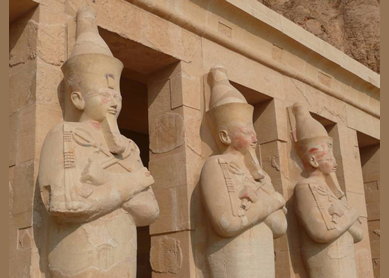Even though Egypt plays a central role in the Bible, Egyptian influence on the biblical text is not very great. The Bible knows relatively little about Egypt as a state. Only four pharaohs are mentioned, none of whom ruled during the historical period in which the biblical chronology locates the exodus narrative and the Joseph story. All four pharaohs are rulers from the first half of the first millennium B.C.E., and three of them can be dated to the seventh and sixth centuries B.C.E. (Tirhakah,
The exodus narrative offers only general knowledge of Egypt. The Joseph story is more specific, as it mentions three Egyptian names and several Egyptian motifs. The embalming of Jacob (
The biblical text demonstrates some knowledge of Egyptian religion. References to Egyptian deities can be found in several personal names: Asenath (from the goddess Neith;
Direct literary parallels can be found in only three biblical texts. Psalm 104, a creation psalm, shares a number of motifs with the Great Hymn to the Aten from the Amarna period (14th–13th centuries B.C.E.). In the book of Proverbs, a whole paragraph (
In sum, the degree of Egyptian influence on the biblical text is remarkably low. The relatively few cases of Egyptian influence most likely occurred through two modes of cultural contact: indirect contact that occurred during the transition from the second to the first millennium B.C.E., when Egypt controlled the southern Levant, and direct contact that began in the late eighth/early seventh centuries B.C.E.
Bibliography
- Schipper, Bernd U. “Egypt, Ancient, II: Hebrew Bible/Old Testament.” Pages 497–99 in vol. 7 of Encyclopedia of the Bible and Its Reception. Edited by Hans-Josef Klauck et al. 30 vols. Berlin: de Gruyter, 2013.
- Redford, Donald B. Egypt, Canaan, and Israel in Ancient Times. Princeton: Princeton University Press, 1992.
- Schipper, Bernd U. “Egypt and Israel: The Ways of Cultural Contacts in the Late Bronze Age and Iron Age (20th–26th Dynasty).” Journal of Ancient Egyptian Interconnections 4 (2012): 30–47.
- Görg, Manfred. “Biblical Tradition.” Pages 171–74 in vol. 1 of The Oxford Encyclopedia of Ancient Egypt. Edited by Donald B. Redford. 3 vols. New York: Oxford University Press, 2001.



